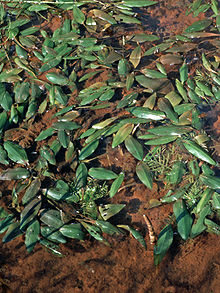Knotweed pondweed
This article was based on formal or substantive deficiencies in the quality assurance biology in the section "plants" entered for improvement. This is done in order to bring the quality of the biology articles to an acceptable level. Please help improve this article! Articles that are not significantly improved can be deleted if necessary.
Read the more detailed information in the minimum requirements for biology articles .
| Knotweed pondweed | ||||||||||||
|---|---|---|---|---|---|---|---|---|---|---|---|---|

Knotweed pondweed ( Potamogeton polygonifolius ), illustration |
||||||||||||
| Systematics | ||||||||||||
|
||||||||||||
| Scientific name | ||||||||||||
| Potamogeton polygonifolius | ||||||||||||
| Pourr. |
The knotweed pondweed ( Potamogeton polygonifolius ) is a perennial representative of the family of the pondweed plants (Potamogetonaceae).
description
The knotweed spawn reaches a height of 10 to 60 cm. The stem is only slightly branched. The floating leaves are up to 9 cm long and 4 cm wide, egg-shaped to lanceolate, narrowed at the base or slightly heart-shaped, sometimes with a slight fold. The petiole is widened, without a flexible joint. Median nerve on the underside of the blade thick, spongy. The diving leaves are still present at flowering time, lanceolate, blunt, thin and narrowed into a long stalk. The median network is clearly visible. The reddish stolons are up to 10 cm long, briefly structured and creep in the ground and are 2 mm thick as the stem.
The flower spike has a loose and narrow structure, the stem is thin. The fruits are 1.5–2.5 mm long nuts, which are bluntly keeled on the back.
The knotweed leek flowers from May to October.
The chromosome number of the species is 2n = 26.
Occurrence
distribution
The knotweed pondweed occurs in the temperate zones of the northern hemisphere. It is common in Europe, in North Africa it is rarely found in the coastal regions. In Europe, the closed distribution area extends north to approx. 60 ° north latitude, isolated occurrences can be found in Norway up to 68 ° north latitude, eastward the occurrences reach up to approx. 20 ° east longitude, whereby the plant is very rare in eastern Central Europe.
The species is rare in northwestern Central Europe, otherwise it occurs only sporadically. In Germany , it is particularly widespread in the northwestern lowlands and along the Baltic Sea coast. Otherwise there are only a few scattered occurrences in the Rhine area (south to the Palatinate) and in the lower Main area. The species is endangered and is in decline in many places.
Locations
The knotweed pondweed prefers low-lime, moderately acidic peat soils and is therefore only found in bog drainage ditches, peat cuttings, bog pools and deeper gullies , in which a little sand should be mixed with the subsoil. It endures temporary drought and then forms landforms.
The knotweed pondweed forms its own plant community, Hyperico-Potametum oblongi, or grows in strandling communities , but also in poorer water lily stocks and in stocks of the small water hose .
literature
- Dietmar Aichele, Heinz-Werner Schwegler: The flowering plants of Central Europe . 2nd Edition. tape 5 : Swan flowers to duckweed plants . Franckh-Kosmos, Stuttgart 2000, ISBN 3-440-08048-X .
- Henning Haeupler, Thomas Muer: picture atlas of the fern and flowering plants of Germany . Published by the Federal Agency for Nature Conservation (= The fern and flowering plants of Germany . Volume 2 ). 2nd corrected and enlarged edition. Eugen Ulmer, Stuttgart (Hohenheim) 2007, ISBN 978-3-8001-4990-2 .
- Heinz-Dieter Krausch : color atlas water and bank plants . Eugen Ulmer, Stuttgart (Hohenheim) 1999, ISBN 3-8001-3352-0 .
- Siegmund Seybold : The flora of Germany and the neighboring countries. A book for identifying all wild and frequently cultivated vascular plants . Founded by Otto Schmeil , Jost Fitschen . 95th completely revised and expanded edition. Quelle & Meyer, Wiebelsheim 2011, ISBN 978-3-494-01498-2 .
- Oskar Sebald, Siegmund Seybold, Georg Philippi (Hrsg.): The fern and flowering plants of Baden-Württemberg . 2nd expanded edition. tape 2 : Special part (Spermatophyta, subclass Dilleniidae): Hypericaceae to Primulaceae . Eugen Ulmer, Stuttgart (Hohenheim) 1993, ISBN 3-8001-3323-7 .
Individual evidence
- ^ Erich Oberdorfer : Plant-sociological excursion flora for Germany and neighboring areas . 8th edition. Page 106. Stuttgart, Verlag Eugen Ulmer, 2001. ISBN 3-8001-3131-5
- ↑ Rafaël Govaerts (ed.): Potamogeton polygonifolius. In: World Checklist of Selected Plant Families (WCSP) - The Board of Trustees of the Royal Botanic Gardens, Kew . Accessed June 1, 2020.
photos
- http://wilde-planten.nl/duizendknoopfonteinkruid.htm
- http://www.fugleognatur.dk/images/galleri/mosen%20089.jpg
- http://www.plant-identification.co.uk/images/potamogetonaceae/potamogeton-polygonifolius-5.jpg
- http://www.biolib.de/thome/band1/tafel_032_small.jpg
Web links
- Potamogeton polygonifolius. In: FloraWeb.de.
- Knotweed pondweed . In: BiolFlor, the database of biological-ecological characteristics of the flora of Germany.
- Profile and distribution map for Bavaria . In: Botanical Information Hub of Bavaria .
- Distribution in the Netherlands [1] (Dutch)
- Potamogeton polygonifolius Pourr. In: Info Flora , the national data and information center for Swiss flora .
- Distribution in the northern hemisphere from: Eric Hultén, Magnus Fries: Atlas of North European vascular plants. 1986, ISBN 3-87429-263-0 at Den virtuella floran. (swed.)
- Thomas Meyer: Data sheet with identification key and photos at Flora-de: Flora von Deutschland (old name of the website: Flowers in Swabia )
